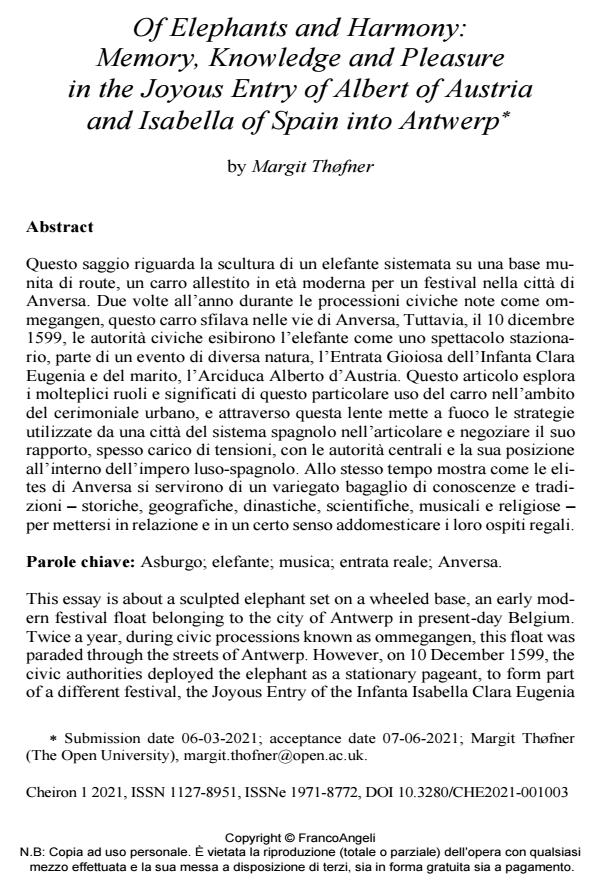Of Elephants and Harmony: Memory, Knowledge and Pleasure in the Joyous Entry of Albert of Austria and Isabella of Spain into Antwerp
Titolo Rivista CHEIRON
Autori/Curatori Margit Thøfner
Anno di pubblicazione 2022 Fascicolo 2021/1 Lingua Inglese
Numero pagine 29 P. 39-67 Dimensione file 1420 KB
DOI 10.3280/CHE2021-001003
Il DOI è il codice a barre della proprietà intellettuale: per saperne di più
clicca qui
Qui sotto puoi vedere in anteprima la prima pagina di questo articolo.
Se questo articolo ti interessa, lo puoi acquistare (e scaricare in formato pdf) seguendo le facili indicazioni per acquistare il download credit. Acquista Download Credits per scaricare questo Articolo in formato PDF

FrancoAngeli è membro della Publishers International Linking Association, Inc (PILA)associazione indipendente e non profit per facilitare (attraverso i servizi tecnologici implementati da CrossRef.org) l’accesso degli studiosi ai contenuti digitali nelle pubblicazioni professionali e scientifiche
This essay is about a sculpted elephant set on a wheeled base, an early modern festival float belonging to the city of Antwerp in present-day Belgium. Twice a year, during civic processions known as ommegangen, this float was paraded through the streets of Antwerp. However, on 10 December 1599, the civic authorities deployed the elephant as a stationary pageant, to form part of a different festival, the Joyous Entry of the Infanta Isabella Clara Eugenia and her husband, Archduke Albert of Austria. This article explores the many roles and resonances pertaining to this specific use of the float. The article is therefore a detailed case study of how one Habsburg subject city deployed one particular sculpture within urban pageantry to articulate and negotiate its often fraught relationship to its overlords and its position within the broader Luso-Hispanic Empire. At the same time, I show how the Antwerp urban elite drew on diverse forms of knowledge - historical, geographical, dynastic, scientific, musical and religious - to address and, to a certain extent, domesticate their courtly visitors.
Questo saggio riguarda la scultura di un elefante sistemata su una base munita di route, un carro allestito in età moderna per un festival nella città di Anversa. Due volte all’anno durante le processioni civiche note come ommegangen, questo carro sfilava nelle vie di Anversa, Tuttavia, il 10 dicembre 1599, le autorità civiche esibirono l’elefante come uno spettacolo stazionario, parte di un evento di diversa natura, l’Entrata Gioiosa dell’Infanta Clara Eugenia e del marito, l’Arciduca Alberto d’Austria. Questo articolo esplora i molteplici ruoli e significati di questo particolare uso del carro nell’ambito del cerimoniale urbano, e attraverso questa lente mette a fuoco le strategie utilizzate da una città del sistema spagnolo nell’articolare e negoziare il suo rapporto, spesso carico di tensioni, con le autorità centrali e la sua posizione all’interno dell’impero luso-spagnolo. Allo stesso tempo mostra come le elites di Anversa si servirono di un variegato bagaglio di conoscenze e tradizioni - storiche, geografiche, dinastiche, scientifiche, musicali e religiose - per mettersi in relazione e in un certo senso addomesticare i loro ospiti regali.
Keywords:Asburgo; elefante; musica; entrata reale; Anversa.
Margit Thøfner, Of Elephants and Harmony: Memory, Knowledge and Pleasure in the Joyous Entry of Albert of Austria and Isabella of Spain into Antwerp in "CHEIRON" 1/2021, pp 39-67, DOI: 10.3280/CHE2021-001003